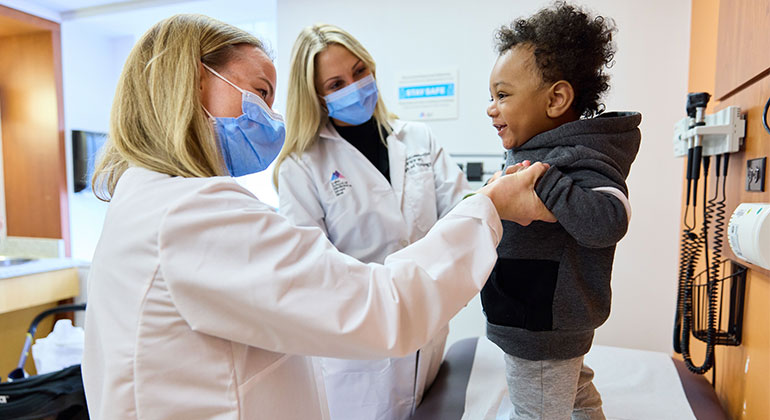Pediatric Incontinence Program (PIP)

When children have a hard time urinating properly, they—and their families—need advanced and compassionate care. The condition, called voiding dysfunction, can affect children physically, socially, and psychologically. If left untreated, it can damage the kidneys.
Pediatric Incontinence Program (PIP) at Mount Sinai Kravis Children’s Hospital, led by Eva Baldisserotto, MSN, RN, CPNP-PC, CPHON and Erin Miller, MSN, RN, CPNP-PC, can help. We work with children and their families to diagnose and successfully treat voiding dysfunction, also known as bowel and bladder dysfunction. We also treat children for daytime incontinence and bed-wetting, urinary frequency, urinary tract infections, and constipation. Our approach is holistic and interactive.
What is Voiding Dysfunction?
Voiding dysfunction is when children cannot completely empty their bladder. The bladder is the part of the body that holds urine until you are ready to release it. Normally, the bladder stretches as it fills with urine. It contracts as your child urinates (voids). When the bladder works properly, it opens completely, easily, and without interruption. If the flow of urine is interrupted or incomplete, your child may have voiding dysfunction.
There are several possible causes of voiding dysfunction. These are:
- A neurological issue where the brain does not communicate properly with the bladder
- Urinary tract infection
- Learned behavior caused when children hold in their urine too often
Signs and Symptoms
The first sign of voiding dysfunction is when a child cannot control the flow of urine. Other symptoms can include:
- Blood in the urine
- Daytime wetting
- Feeling that the bladder is always full
- Frequent urination
- Nighttime wetting
- Pain when urinating
- Pain in the lower back of the abdomen
- Straining to urinate
- Urinary tract infection
Diagnosis
Once a child is potty trained, usually by age four, we can diagnose voiding dysfunction. The first step is to find out if some other condition is causing the dysfunction. If, for instance, your child has a urinary tract infection (UTI), it can lead to voiding dysfunction; in this case, we will treat the UTI, often with medication.
Next, we track the child’s urinary and bowel function. We will also take a family and social history. Bladder problems can run in families. In addition, if there is a source of stress or a change in routine, it can lead to urinary problems.
We may ask you to keep a daily log of urine and bowel functions. We may assess this information using the Dysfunctional Voiding Scoring System questionnaire or the Bristol Stool Score (kids) (teens).
The next step might be to order diagnostic tests, including blood and urine tests. We might also use imaging tests, such as abdominal X-rays, kidney and bladder ultrasounds, or magnetic resonance imaging to help us see what is going on.
In more complex situations, we may also need to use one or more of the following diagnostic tests:
- Uroflow Electromyography: This test is similar to an ultrasound and involves using sensors while your child urinates, so we can see how the muscles are working.
- Urodynamic Testing: We insert salt water (saline) into the bladder to see how strong the bladder is.
Treatments We Offer
We can use one of several approaches to treat voiding dysfunction. These include:
- Behavior modification: We can help your child change their voiding behavior. For instance, we might have your child urinate on schedule, such as upon awakening and before going to bed.
- Address constipation: Making sure your child drinks enough water (and other healthy liquids) and eats enough food with fiber can often help.
- Pelvic floor therapy: Exercises can teach your child when to relax and contract the pelvic muscles.
- Medication
Additional Conditions We Treat
In addition to voiding dysfunction, we can help diagnose and treat other conditions. These include:
- Bed-wetting: Involuntary urination during sleep after age five
- Daytime incontinence: Also called daytime wetting, this is urine leakage or passing urine unexpectedly during the day after toilet training age
- Urgency frequency syndrome: The sudden and strong urge to urinate and/or the need to urinate more often than normal
- UTI: An infection in any part of the urinary system, including the urethra, bladder, ureters, or kidneys
- Constipation: The bowel is filled with too much stool. This can happen when food takes too long to pass from the mouth to the toilet. It can lead to infrequent bowel movements or difficult passage of stools that persists for several weeks.
- Overactive bladder (OAB): Your bladder sends a signal to the brain that it needs to empty, even before it is full. Also called “detrusor instability” or “unstable bladder.” With OAB, you may have urinary urgency, frequency, and bed-wetting with or without urinary incontinence.